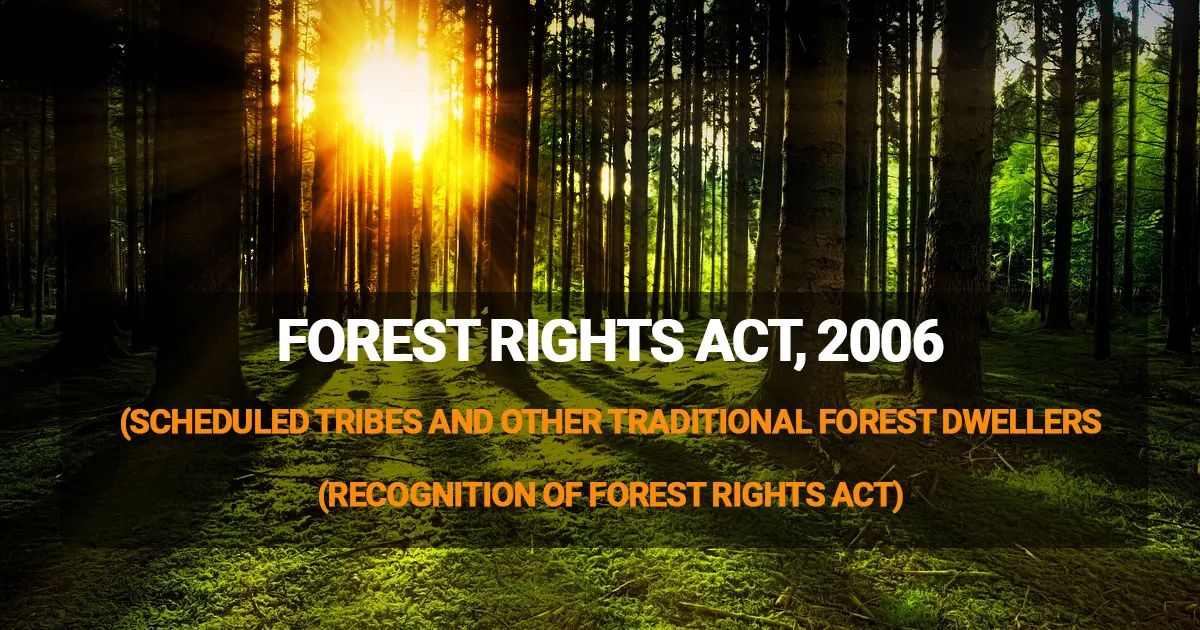GS 3 – Environment – Act

The Forest Rights Act (FRA) of 2006 is a landmark legislation aimed at addressing the historical injustice meted out to forest-dwelling communities in India. It recognizes and vests forest rights in Scheduled Tribes (STs) and Other Traditional Forest Dwellers (OTFDs).
Key Provisions of the Act
Objective:
-
- To recognize the rights of forest-dwelling communities who depend on forests for their livelihood and survival.
- To ensure their access to and control over forest resources for sustainable development.
Types of Rights:
-
- Individual Rights: Ownership and access to land cultivated by STs or Other Traditional Forest Dwellers (OTFDs) (up to 4 hectares) for livelihood purposes.
- Community Rights: Use and access to minor forest produce, grazing grounds, water bodies, etc.
- Right to Protect and Conserve: Communities have the right to protect, regenerate, and manage forests sustainably.
- Habitat Rights: Recognized for Particularly Vulnerable Tribal Groups (PVTGs).
- Relief and Development Rights: In cases of displacement, forest-dwellers are entitled to rehabilitation.
Eligibility Criteria:
-
- Scheduled Tribes (STs): Must reside in and depend on forest land as of 13 December 2005.
- Other Traditional Forest Dwellers (OTFDs): Must have resided for three generations (75 years) on the forest land prior to 13 December 2005.
Institutional Framework:
-
- Gram Sabha: Plays a critical role in determining and verifying claims.
- Forest Rights Committees: Constituted by Gram Sabhas for processing claims.
- State Level Monitoring Committees (SLMCs): Oversee implementation.
Importance of the Act
Social Justice:
-
- Restores the traditional rights of tribal and forest-dependent communities.
- Empowers vulnerable communities, particularly PVTGs.
Livelihood Security:
-
- Provides legal ownership of land and forest produce.
- Enhances access to minor forest produce and other resources.
Environmental Conservation:
-
- Recognizes the role of tribal communities in sustainable forest management.
- Integrates ecological concerns with livelihood needs.
Governance Reform:
-
- Strengthens decentralized governance through Gram Sabhas.
- Promotes participatory forest management.
Challenges in Implementation
- Delayed Recognition: Slow progress in recognizing rights due to bureaucratic hurdles.
- Rejection of Claims: High rate of claim rejection, often without proper reasons or legal support.
- Conflict with Conservation Laws: Overlaps with forest and wildlife conservation policies, leading to conflicts.
- Lack of Awareness: Many forest dwellers are unaware of their rights under the FRA.
- Pressure from Commercial Interests: Encroachment by industries for mining, infrastructure, or plantation projects.
[box] Discuss the significance of the Forest Rights Act, 2006, in addressing historical injustices against forest-dwelling communities and promoting sustainable forest management. Examine the challenges faced in its implementation.
[button color=”purple ” size=”medium” link=”https://forms.gle/Wzz7M6oVE4bQS8Ws8″ icon=”” target=”true”]Upload Answer[/button]
[/box]




